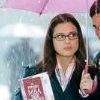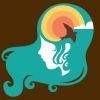The
movie opens with an extreme closeup of Grufus Scrimgeour's (minister of
Magic) as he's giving a very haunting press conference about all the
dangers and horror going around in the wizarding world. The scene zooms
out as it turns into a picture in a newspaper. We see the Dursleys
packing up, leaving Harry behind, and their house in Pivot Drive
completely empty. There's another scene that starts out with Hermione
looking worried in her bedroom. The filmmakers then decided to show
Hermione hexing her parents to forget their current lives and move to
Australia. After she does this, she also makes all images of her
disappear from the pictures in their house. This scene was very well
done and was one of my favorites in the whole movie. It was very
effective because it quietly communicated the dread wizards were
feeling due to Voldemort. There's a shot in the trailer of Hermione
walking towards what looks like a church. She's not really heading
there. It's just part of a shot of her walking down her street, as the
camera pans up to reveal the titles. One thing to note about that:
since the movie score isn't completed yet, they were using a variety of
music from other movies, they had some music from Harry Potter, but I
would say most of it sounded very much like a Hans Zimmer score. It was
a little bizarre to see the Harry Potter And the Deadly Hallows title
set to one of the most recognizable cues from The Dark Knight score.
If
I recall correctly, we then see a shot of Snape arriving at Malfoy
Manor, where there's a very chilling sequence of Voldemort explaining
to the death eaters about the shared core between his wand and Harry's.
The Hogwarts teacher who had been captured and tortured can be seen
floating above the table throughout the whole scene. We also get a very
intense exchange between Voldemort and Lucius Malfoy, when Voldemort
asks for his wand in order to be able to kill Harry. The actor who
portrays Lucius does a good job of selling the internal humiliation
Lucius feels as his wand is taken away. Then Voldemort brings the
teacher forwards, and shortly after she pleads for Severus' help, she
is killed.
We
then cut to Harry waiting for the Order of the Phoenix to arrive. One
of the things that I was very impressed with in the movie was how
despite it being the darkest Harry Potter movie of all, it also had a
lot of light hearted humorous parts. The seven Harrys scene is one of
the best examples of this. As we see the decoys taking the polyjuice
potion, the camera pans 360 degrees around the real Harry seeing all of
them transforming. After, when they are changing, there's a very funny
moment when they're all commenting on Harry's eyesight, and Fleur
comments how hideous she is as she takes of her bra. The sight gag of
Dan Radcliffe taking off a bra got a lot of laughs from the audience.
The scene plays out pretty much like the book, with the big exception
of Harry and Lupin not having the heated argument they have in the
book. In fact, Tonks' pregnancy is brushed aside. It was a little
frustrating if you've read the book, because they didn't just omitted
it, but literally brushed it aside: just as Tonks is about to make her
announcement, Mad-Eye pushes her aside and discusses how important it
is to move Harry. Mundungus Fletcher is briefly introduced without much
background in this scene, though it is established that he's forced to
be there and that he's a sketchy character.
Right
before they leave, we see the scene of Harry releasing Hedwig from his
front door, as seen in the recent publicity shots that have been
circling around the web. The chase scene that follows is very exciting,
though it mostly focuses on Harry and Hagrid (who is stupefied or
paralyzed shortly after the chase begins, leaving Harry to fend for
himself). The chase itself is very exciting, and takes place high in
the sky, and on the street level, including a sequence through a tunnel
that has the motorcycle doing a loop and Harry tippy-toeing on a truck
as he hangs on for dear life. Hedwig's death is a big change from the
book; and one, I think is an improvement. Instead of the Death Eaters
finding out who the real Harry is because he used Expelliarmus, they
find out because Hedwig is flying close to him protecting him. In the
movie, as Harry's about to get hit with a death curse, Hedwig gets in
the way and gets killed. Hagrid wakes up as they enter the protected
area by the Weasley's and one by one the Order of the Phoenix arrives.
We do not see Mad-Eye's death, it is only mentioned that he was killed
after Fletcher escaped. The scene where Lupin grabs Harry for
questioning is identical to the book, and translated great to the
screen.
After,
there's a short scene of Harry trying to leave and Ron convincing him
to stay for the wedding. We later see them putting up the wedding tent
as Rufus Scrimgeour arrives to read the last will of Dumbledore. I
thought the scene was very interesting, and the filmmakers made a very
good effort of trying to maintain the relevance of the items Dumbledore
left them throughout the movie. The golden snitch is usually seen
flying around Harry at various points in the film, Ron's illuminator is
used several times. The Tales of Beedle the Bard are kind of ignored
upfront, but obviously play a large part later on in the film.
The
biggest change in the wedding scene is that Harry attends without any
disguise. We see cameos from some old characters like Madam Maxine and
Victor Krum (who dances with Hermione as Ron jealously watches in the
background). This is also where we meet Mr. Lovegood, who was perfectly
cast and portrayed. The camera purposely focuses on his necklace, but
nothing is mentioned about it. We do not learn its significance until
later, and there is no argument between him and Krum.Then there's a
short, but good conversation between Harry, Aunt Muriel and Elphias
Doge in which some exposition is given to Dumbledore's past. The
actress playing Aunt Muriel makes a very good job at teasing Harry for
not knowing Dumbledore. The wedding is cut short by the Patronus
announcing the fall of the Ministry and the impending arrival of the
Death Eaters. After a chaotic exit, we see the trio go into the coffee
shop, where they are attacked by another pair of Death Eaters. There's
a nice bookend sequence here where Hermione uses the same memory charm
on one of the Death Eaters that she used on her parents.
The
Grimmauld place sequences are very shortened compared to the ones in
the book. The trio discovers that RAB is Regulus Black very quickly and
there's no doubt it's him who took the locket. Harry then finds Krecher
and sends him after Mundungus Fletcher when he finds out he stole the
locket. The whole subplot with the dual portraits in Grimmauld place
and the Hogwarts Headmaster's office was cut. There's short sequence at
Diagon Alley, where we see Fletcher hiding from people (and the first
sighting of the Harry Potter Undesireable #1 poster). The movie then
cuts to Harry, Ron and Hermione sitting around a table, when they hear
a noise, then they notice Mundungus Fletcher with Kreacher hanging
around his neck. Then, in what got one of the biggest reactions from
the audience, Dobby greets Harry Potter as the camera pans to show him
dangling from Fletcher's leg. After a quick interrogation, they realize
they need to go to the Ministry.
The
Ministry sequence plays out almost exactly like the book. I have to
say, seeing people flush themselves down a toilet to get there was very
funny, especially because when we first see the bathroom, every stall
has a line of people constantly going in but no one coming out. One
thing that stood out is that the filmmakers were going to great extents
to draw comparisons between the crusade against Muggles and Nazis. The
statue at the entrance of the Ministry has been replaced by one of
Muggles being crushed to death by wizards. Later, when Harry enters
Umbridge's office, we see workers making anti-muggle propaganda that
looks almost exactly like Nazi propaganda. The guards at the ministry
even have red bands around their arms, similar to Nazis. This was a
little jarring for me even if it was also very strongly implied in the
books, mostly, I think because of how visually obvious it is. The
effects from their escape out of the ministry were very unfinished, but
they include a run-in with Dementors in the court room, and some back
and forth spell casting with Ministry storm troopers. Finally, we see
them apparate in the wilderness, and Ron's arm being severely hurt,
which puts him out of commission for a while, and sets the stage for
his jealousy and eventual leaving.
After
that, the movie slows down quite a bit, as we enter the scenes set when
Harry, Ron and Hermione walk around in the wilderness. I was afraid
that the movie was going to have the same pacing problems as the book
had during these sequences, and I was not proven wrong. These scenes
tend to drag a bit, especially because the first part of the movie is
so full of action sequences. One thing that makes these scenes more
interesting than the book's is that the locations they used to film
these are absolutely stunning. Props to the location scouts for finding
these places. Another big element in this set of scenes is the horcrux
locket, and the effect it has on whoever wears it. In a way, these
scenes almost feel like a Lord of the Rings homage, due to the constant
wide shots of pretty landscapes and the similar ways in which the
locket and the One ring affect whoever is wearing it.
It
is interesting to note that, while Ron listens to his radio, the
Potterwatch subplot is mostly overlooked. Since the movie is very much
focused only on what Harry, Ron and Hermione are doing (think, for
example, how in War of the Worlds or Signs we never really see what's
going on in the outside world), I thought the underuse of Potterwatch
was a missed opportunity to show how horrible things were out in the
rest of the world.
The
scenes of Ron arguing with Harry and Ron abandoning them were very well
acted, in my opinion. The performances were all around the best in any
of the Potter movies, especially from the main three characters.
After
Ron leaves, Harry and Hermione decide to go to Godric's Hollow. The
scene right when they arrive is another one of my favorite scenes from
the movie. The setting and tone are very dark, like the rest of the
movie, but it is contrasted with the snow and the caroling they hear
from a nearby church. The scene when Harry finds his parent's tomb is
as close to perfect as possible. A very creepy Bathilda Bagshot shows
up at the cemetery and leads them to her house. Just as in the book,
she does not speak in front of Hermione, and takes Harry upstairs,
where she speaks to him in Parsel (a change from the book, where we do
not learn that it's Parsel until later.) The effect of Nagini coming
out of Bathilda were mostly incomplete. In particular, we saw what
seemed to be a place holder for the most graphic scene of Bathilda's
skin falling to the ground as Nagini comes out. What we saw were a
couple of quick shots of her jumping out. Voldemort does not show up at
Godric's Hollow before they disapparate out.
We
see Harry having another of the dreams / shared memories he's had
throughout the movie, bringing him one step closer to finding out about
the elder wand. When he wakes up, Hermione tells him he's been out cold
for a while. I can't remember if this is where this particular scene is
placed in the movie, but the filmmakers added a very very good scene of
Harry and Hermione setting the locket (and therefore, their worries)
aside, and they have a very awkward, but touching dance in the tent. It
was also one of my favorite scenes in the movie, because it brought
some levity to all the bad moments they'd been through up to that
point.
Afterwards,
we see the scene of the Doe patronus leading Harry to Griffindor's
sword, and the scene plays out much like the book, including a very
dramatic reveal that it's Ron who rescues Harry from drowning in the
freezing water. After they get Griffindor's sword, Harry opens the
locket so Ron can destroy the Horcrux. When it opens, a massive
creature that looks a little like the Smoke monster from Lost appears
and tries starts taunting Ron with everything that made him leave in
the first place. The sequence hits a high point with what I think will
be one of the most talked about things in this movie: a silvery
illusion Harry and Hermione are shown making out topless. Great acting
by Rupert Grint in this scene.
After
that, they decide to visit Mr. Lovegood, where they finally learn about
the symbol of the Hallows. In an inspired choice by the filmmakers, we
do not only hear the Tale of the Three Brothers as Hermione reads it,
but also shown it through an animation sequence. It's a little tough to
describe, but I'll try my best. It's a pretty barebones animation set
against a simple background that looks like old and yellowed paper. The
characters look basically like 3D animated stick figures, and almost
like a scaled back version of something Tim Burton would do. Everyone I
talked to thought that the sequence was a very clever way to get
through a lot of exposition.
Another
change from the book is that Mr. Lovegood calls the Death Eaters to his
house by saying Voldemort's name outloud. (The taboo was mentioned by
Ron earlier in the movie, but not really explained.) After they manage
to escape the attack, they apparate immediately to where the snatchers
are. They get chased down through the forest, shooting spells from
their wands. The scene seemed to be shot with a hand held camera, and
there was a lot of shaking and quick cuts, like a Jason Bourne chase
sequence. The effects on this scene also looked like a work in
progress, and there was no music (and since most of the movie had a
temporary score, we don't know if they intentionally left no music for
this sequence.) They get caught, but not before Hermione deforms
Harry's face so that he's not recognized, and then they get taken to
Malfor Manor.
Given
that the movie was going to be split, I thought that the escape from
Malfoy Manor would be emphasized more, and the action increased, so as
to give the movie one final large action sequence before the cut.
However, it seemed to go much faster than I anticipated. After
Bellatrix notices Griffindor's sword, she keeps Hermione for torture
and sends the rest of them to the dungeon. The torture scenes are very
intense, but a lot of what makes the scene work is seeing the
characters in the dungeon react to Hermione screaming in pain.
Bellatrix cuts the word Mudblood into Hermione's forearm. Harry looks
into the mirror shard (something he's been holding the entire movie,
while looking at Dumbledore's eye the whole time), and soon after,
Dobby apparates to help Harry. An interesting note is that Wormtail is
stunned by Dobby but he does not die in the movie. Given how much I
hate that character, I hope they're just saving it for the second part.
After
they escape the dungeon, the confrontation and escape from the Manor
goes very quickly. Dobby drops the chandelier, Harry dodges and
wrestles Draco's wand from him (another interesting point is how Tom
Felton played Draco with a lot of uncertainty of what's happening
around him. In this sequence, for example, Draco barely puts up a fight
with Harry for his wand, and the whole time, Draco has a conflicted
look on his face). The scene ends with Dobby gathering everyone around
him in order to apparate in Bill and Fleur's house. Before they leave,
we see Bellatrix throw a knife at the group, and the whole scene is set
in slow motion, so you see the knife flying towards Dobby, while at the
same time we see the apparition portal opening up. We do not see what
happens with the knife at this moment. Then the movie cuts to a beach,
where Harry yells happily that they're all OK; until he notices that
Dobby had been stabbed in the heart with the knife Beatrix threw. Dobby
dies in Harry's arms, and he declares he wants to bury him
traditionally, with no magic. This is the last we see of our heroes.
The
final shot of the film is the only to take place in Hogwarts, (I didn't
see the castle, but it is likely that it will be added later) and it's
Voldemort flying towards Dumbledore's tomb, cracking it open, and
taking the Elder Wand from his dead hands. The camera focuses on
Voldemort's joyous face as he obtained the only Hallow he was looking
for, the camera zooms out and we see he's conjuring up a massive and
ominous cloud. The end.
I
would say this is my favorite Harry Potter movie since Prisioner of
Azkaban without a doubt. It is also the most faithful to the books
since movies 1 and 2. I'm still conflicted about the split because it
both feels appropriate and like an excuse to extend the series at the
same time. The movie benefits from not having the action and narrative
compressed like the last few movies, but at the same time, the cut
feels a little artificial, especially if you've read the book. My
biggest complaint with the split is that the movie ends shortly after
we learn about the Hallows (and by extension, the reason for the
title). That's the moment when the story moves away from the three
characters trying to figure out the plot, to the characters having a
good understanding about what's going on and what they need to do next.
Because of this, the movie doesn't seem to have that strong a narrative
compass as it could. Once both movies are out, it won't make sense to
watch this part without watching part 2 shortly after, and in the
meantime, this movie suffers a bit because of this.
Most
of the omissions and changes from the book seemed to be either
improvements, or changes that were made to simplify the narrative and
avoid unnecessary exposition. The best example would be the change in
the role of Hedwig at the beginning of the film. Keeping the
Expeliarmus explanation would have added a lot of confusing exposition
to the movie. The change allowed for a more streamlined narrative, and
also for Hedwig's death to be more meaningful. They can also trim a
little from the middle sequences in the forest. That part seemed to
drag a little, just like in the book. However, these complaints are
minor, and do not detract significantly from the film.
Overall,
I believe the movie lived up to expectations, and it bodes well for
Harry Potter and the Deathly Hallows Part 2, since they got a lot of
the exposition out of the way, they'll be able to make a more action
packed and exciting movie.
If you have any questions, leave a comment and I'll try to answer as best I can!











comment:
p_commentcount